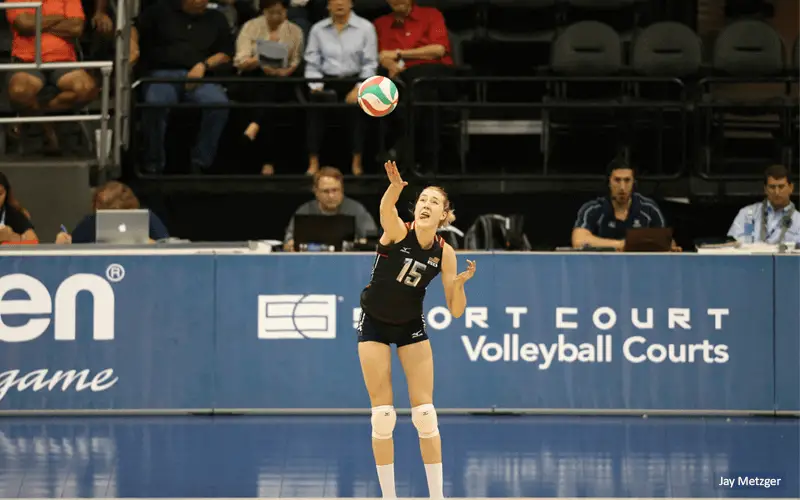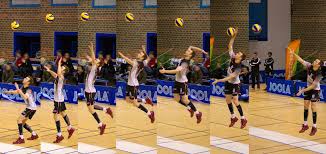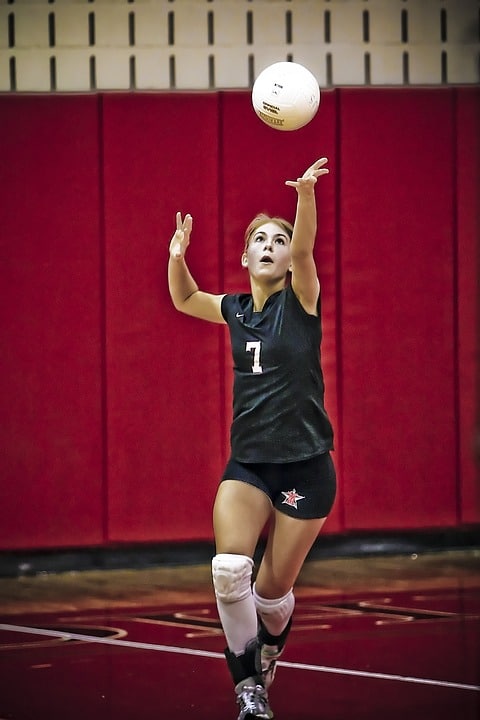
Serving is an extremely important aspect in Volleyball as it signifies the start of every single rally.
Being a great server is a difficult task as it requires you to not only be extremely consistent, but also make your serves tough and challenging.
Having a weak serve not only makes it easy for the opposing team to receive but also may mean you give the point away without the other team even having to lift a finger.
Obviously we want to avoid this at all costs.
There are primarily 3 different types of serve in Volleyball.
- Standing Float
- Jump Float
- Topspin
Table of Contents
Standing Float

The standing float serve is an extremely useful skill to master as it requires little energy and minor movements making it easy to pick up and master.
On top of being easy to learn it can also be one of the trickiest serves to receive and when a float serve is executed correctly, the ball will move in the air and almost change direction mid flight making it very hard to judge.
Jump Float

The jump float takes the above process and in most cases improves upon it.
By adding a jump into the equation it means the serve is contacted from a higher point meaning the serve can be hit with more power and ultimately drastically reduce the time the opposing side has to react and pass the ball.
Now you may have read that and been somewhat confused as to why adding a jump means you can hit the ball harder.
When standing some of the energy generated from the serve needs to be used to get the ball up and over the net whilst still landing in court. This makes the serve have an almost loopy arch.
However when you contact the ball from near or above the height of the net you can focus all that energy to making the ball go downwards and directly onto your opponent’s side.
The jump float is a harder to master but can yield more rewarding results.
Topspin Jump Serve

The last serve is the one everybody wishes they could do with power and consistency.
The topspin jump serve is a tricky beast to tame and an even harder one to master.
The topspin jump serve involves throwing the ball upwards and in front of yourself behind the service line and then attacking the ball almost like a spike.
The aim of the jump serve is to hit the ball with such power and accuracy that the opposition team either can’t touch the ball at all or it is too fast and difficult for them to perform a controlled accurate pass to the setter.
Topspin jump serve can be quickly learnt however unless they are performed with an amazing degree of accuracy you will often find the float serve offers better reward.
A powerful jump serve hit directly at an opponent can be easily passed as the passer does not need to generate any energy themselves, they simply aim their body to the target and absorb the energy.
With that being said I would suggest leaving jump serving until you really feel comfortable with timing, approach and spiking action.
When it comes to first learning to serve the most commonly taught serve will be the standing float serve.
Now typically it is far more important for the players to learn simply how to serve over the net and worry less about getting the float portion of the serve.
Being able to serve over the net is something that will seem easy and come naturally to some however, for the vast majority of players it will not be such an easy process.
Serving is one of them frustrating skills that when spectated looks simple and easy, however, when it comes to actually performing the skill for the first time, it quickly becomes apparent that it is not quite as simple as it seems.
As with every skill the first thing we want to do is ensure we understand exactly how the serve should be executed before moving into specific drills.
How To Serve In Volleyball
To overhand serve a volleyball it can really be broken down into 3 core sections.
- The toss
- The Armswing
- The Contact
In order to be a consistent server all 3 of these sections need to be executed perfectly and in a smooth and seamless manner.
To help speed up the beginners progression with serving I would suggest teaching the serve by starting with the first section and then gradually introduce the second and then third sections.
The Toss
One of the most common reasons in which beginners struggle to serve the ball accurately or even over the net is due to an inconsistent ball toss.
By having an inconsistent ball toss it means the beginner must contact the ball from a different location each time which doesn’t allow the body to adjust to the new mechanics and transfer this skill over to muscle memory.
To correct this as silly as it stands we want to just in initially practice the ball toss section only.
To correctly ball toss we either take the ball in one of two hands, which ever feels more comfortable for the beginner in question. Next the player simply wants to toss the ball upwards and slightly in front of themselves.
This allows the player to have enough time to find the ball but also gives a little distance to step into so the body’s momentum can be used to generate that extra power needed to get it over the net.
We want to try to achieve a toss that is the same height and distance away from the player each time.
To better help understand what height and distance works for each individual once they have ball tossed the players should do an arm swing as if they are going to serve, but instead of hitting the ball we simply what to use our guidearm and our hitting arm to catch the ball.
I appreciate that at this moment the players may not know the exact technique regarding arm swing but it is more important at this stage that they work on getting a consistent ball toss as this will make everything easier moving forward.
Arm Swing

The next stage in the overhand serve process is the arm swing.
The arm swing required for overhand serving is much like the hitting action when spiking the ball. This means the arm hitting arm should be cocked back with elbows up nice and high whilst the non-hitting arm goes up to face the target.
If you are unclear on this motion I would suggest you read one of my other articles in which I talk about the archer pose or the Nike Swoosh.
From this position we want to slightly rotate our bodies as our hitting arm comes through to contact the ball and our guide arm comes down across our chest or down by our side.
To best practice this I would suggest the players first do this without a ball to ensure the action is correct. After this I would suggest getting the players to practice this into the net or against a wall so they can concentrate on the arm swing without worrying about where the ball lands.
Contact point
Once the players have got consistent ball toss and smooth seamless arm swing it’s time to put these two skills together and focus on the contact point on the ball.
As we are just starting we are not going to be jumping when serving, this means we need to get the ball to first go up before travelling forward as we want to ensure we give the ball enough hit and power to make it over the net before landing on the opponent’s side.
With this in mind we want to ensure that players are contacting the ball when they are aiming slightly upwards rather than being later and hitting the ball in a more flat trajectory.
Best Beginner Serving Drills
Serving In Pairs
Now the players understand the core concepts of serving it is time to put everything into practice.
Now we could just get everyone standing behind the service line and attempting to get the ball over and in, however, the success rate isn’t likely to be very high as the players start to come to terms with the new actions they have just learnt.
Having a low success rate could lead to a lot of discouragement for the players and ultimately we want to encourage them to help them progress faster.
The way in which can do this is by drastically reducing the distance in which they start serving and give them a target in the form of a partner to aim for.
This not only gives them a clear target but allows the players to focus on the action of the serve without having the extra stress of trying to reach a net over 9m away.
To perform this drill, split the team up into pairs and have them stand on opposite sides of the net to each other. To start the drill I would suggest we first get the players to stand no further back than the 3m line.
This tends to be a nice distance away from the net so that the players don’t feel they need to hit the ball up really high, but they are closer enough that they don’t have to think too much about the power of the serve.
To start the drill simply ask the pairs to serve back and forth to each other, the aim is to serve with enough accuracy that the other player in the pair can catch the ball without moving.
If you notice the players are finding the drill too easy and are able to serve back a forth with a reasonable level of consistency the drill can be expanded by instructing the players to take one large step after every successful serve and catch.
The more this drill is performed the more quickly you will see the players taking a step back and the more consistent the serves will become until the whole team is serving from the back line with ease.
Around the World

Once the players have mastered the art of serving over the net it is time to work on placement and accuracy of the serves.
I like to use a drill called around the world to help the players work on accuracy.
To perform this drill you will need cones or markers that you can use to seperate the court into sections.
Depending on how good the average serving ability it may drastically improve or decrease the number of zones you create.
I like to use 6 zones as this leaves a relatively large area to aim for and also helps the players get used to serving to certain areas in which a weak opposition passer may be stood.
To separate the cort into 6 I would recommend splitting the side directly in half width ways by placing one line halfway between the service line and the net.
Next place down two more lines to split the court in thirds length ways.
This should now leave 6 equal zones for the players to serve into.
To start around the world get all players on one side of the court and lined up along the service line.
The players will take it in turns to serve however they must start by serving in the back left zone. If the player successfully serves in the correct zone they will move on to the next zone which would be the back middle zone (position 6).
The zones move around in a clockwise direction.
If a player misses the desired zone they will remain on that zone until they hit it and move on.
The winner is the person who manages to make it around every zone in the least serves.
If you are restricted for time you may want to consider giving each player 6 serves.
The winner is the person who makes it furthest with their allocated serves.
In order to make the drill more challenging the zones can be made smaller or obscure shapes can be used to make each serve slightly different.
Server Battle

Now the players should all be serving with much greater consistency and after the previous drill hopefully able to serve in specific areas.
To put this to the test I like to do a drill that I have named Server Battle.
To perform this drill split the team in two and ask them to line up on opposite service lines.
The first players from each line will step forward and one of the first two players will have to perform the serve.
The serving players goal is to serve the ball without allowing the opposition player to touch or catch the ball
If the server is able to serve the ball without the opposition player touching it, the server wins 1 point, if the opposition player can touch it, it is a wash and no point is awarded.
If the opposition player is able to catch the ball then the receiver wins the point.
Once the server has gone the serve is given to the player that was just receiving and the game is repeated.
This mini-game will be played to best of 5 points, whichever side wins overall will win 1 point for their side.
The winning side is the team that has the most overall wins after each player has been.
If the drill is going to played again make sure the lines mix up positions to avoid the same players competing against each other again.
This drill is fantastic for teaching players to serve in difficult locations for the opposition to reach.
Although this is solely a serving practice the drill is also brilliant for teaching players to chase down balls that are difficult to receive.
If the players are able to catch the ball they can certainly dig the ball back up in games.
Join Your Friend
If at the start of the session you promised your team a scrimmage at the end of the night if they trained well, this can be a great test of the players ability to put into practice what has just been taught.
To perform this drill you will need one player to sit crossed legged in the middle in the rear half of the court (position 6). All remaining players will line up on the service line on the opposite side of the court.
The player who is sitting at position 6 is not allowed to move from their spot they can only use their arms to attempt to catch the ball.
The remaining players will each be given a ball along the service line.
This is a time based game which is designed to add pressure to the servers to prepare them for game situations.
Once the time limit is set and agreed and everyone is in position you are ready to start the drill.
The players serving are all to serve at the same time trying to get the ball as close as they can to the player sitting down on the floor on the other side.
If the player sitting down catches a ball, the player that served that ball will go and join their friend sitting down next to them and will become a catcher.
The remaining players must run, collect their balls and return to the service line to reserve.
The drill ends if either the time runs out or all players on the team sit down before time runs out.
If the team succeeds they can be rewarded with scrimmage, if they don’t succeed I will leave the evil sinister punishment to you.
